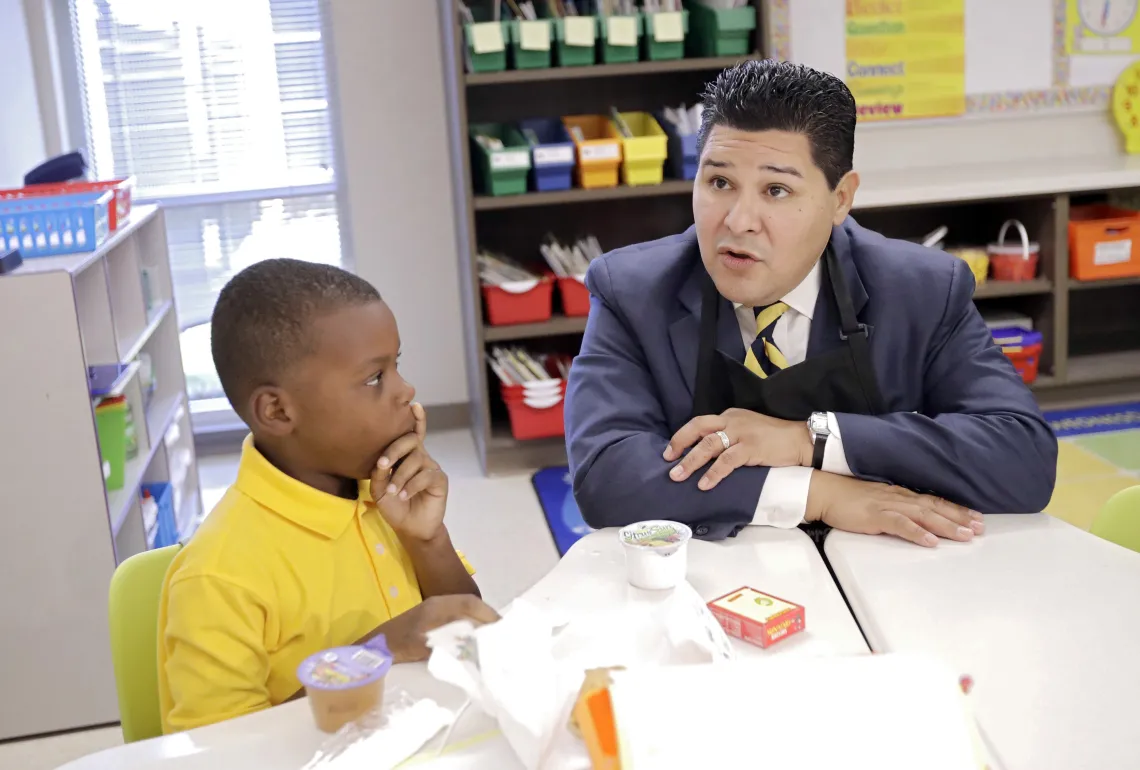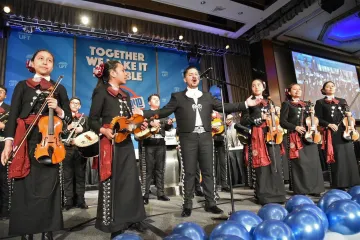‘Canta y No llores — Sing, Don’t Cry’
Living, working and leading in the epicenter of the pandemic

Richard Carranza, then Houston Independent School District superintendent, talks with second grader John Bradford after handing out breakfast to students. / David J. Phillip, Associated Press
In 2018, New York City hired a charismatic new chancellor of schools. Richard Carranza ’91 arrived with a set of mariachi guitars and a plan to disrupt old priorities in a largely segregated system with large Hispanic and Black populations.
And he brought a wealth of experience, too — in his almost 30 years of reshaping schools from San Francisco to Houston, he hadn’t missed a beat.
Then, the shadow of COVID-19 closed schools and forced the system to invent new ways to deliver education to more than a million New York City schoolchildren from 1,800 schools.
Carranza found a way through it, drawing on his experience in Houston — where he quickly reopened schools after the catastrophic Hurricane Harvey — and before that in San Francisco, where one of his key supporters describes him as “probably our nation’s finest school leader.”
Although New York’s battle with the coronavirus dominates his official calendar these days, his cultural roots still fill his heart. Asked what song he’d offer to students and parents in the midst of the pandemic, Carranza didn’t hesitate: “Ay, ay, ay, ay, canta y no llores,” he sang. The words to “Cielito Lindo,” Carranza says, carry his message: “‘Sing, don’t cry.’ It’s uplifting, aspirational. It’s about happiness.”
“Living, working and leading in the epicenter of the pandemic in the U.S. has been surreal in many ways,” Carranza says. “My heart breaks for all that have lost a loved one, but I don’t have the words to laud my colleagues who have continued to serve our students and community during these traumatic times. As difficult as this time is, I have no doubt that we will one day look back and say this was our finest hour.”
In his University of Arizona days, Carranza played with the best of Tucson’s mariachis. They recruited him to sing and play trumpet and guitarron from El Casino Ballroom to Ventana Canyon. And it was more than a way to help pay a student’s bills; music was a force that would drive him into teaching and on to administration to help lift minority students.
He still keeps a guitar close by. In fact, two of them grace the Office of the Chancellor of New York City Schools, near the Brooklyn Bridge in Lower Manhattan, signaling his continuing battle for social change through desegregating classrooms.

Richard Carranza and the New York City Mariachi Conservatory student youth group. / Photo courtesy of Mariachi Juvenil Tapatio De Alvaro Paulino
But they don’t just hang on the wall. Playing gigs in Brooklyn, Carranza says, is his favorite way to escape from the job. Saturday nights, he can trade his dark pinstripe suit and cornflower-blue tie for a black and white charro suit and his classic charro bow tie to perform, incognito, with the Mariachi Tapatío de Álvaro Paulino.
Carranza, 53, was born and raised in Tucson. His grandfather was a copper miner from Cananea in Sonora, Mexico, who settled in Tucson. His father became a sheet metal worker, and his mother was a hairdresser from Magdalena, Sonora, Mexico. Carranza’s parents insisted on speaking only Spanish at home. He began to learn English in kindergarten and was fluent by second grade.
Carranza has eight family members who’ve attended the University of Arizona, including a daughter who is entering her sophomore year. In his own time at the university, Carranza and his twin brother, Reuben, were natural campus leaders; when Reuben ran for student body president with Richard as his campaign manager, he won.
Carranza completed two years in engineering but wasn’t enjoying it. He did love teaching guitar to friends, though, and an adviser steered him toward education classes. With a B.A. in secondary education, he taught social studies and bilingual education at his alma mater, Pueblo High School — and would have continued were it not for one experience: Having founded Mariachi Aztlán, he tried to embed mariachi as core curriculum, calling it “culturally relevant pedagogy.” He hit a brick wall.
“I experienced abject racism aimed at the idea of getting a mariachi program into a school,” Carranza says. Even music teachers, he says, dismissed mariachi as something played in a bar for drunks, not legitimate art.
Frustrated, he decided to take on the larger struggle to influence policy. He became an administrator so he could work to reduce the inequities in public schools. “That’s what drove me from the classroom. Now, my role is to disrupt that,” he says. “Soon I was on the inside, and I could disrupt from the inside.”
He served as superintendent in Las Vegas, San Francisco and Houston before landing the top job in New York — the largest school district in the country. In politically heated New York City, his focus on diversity and college access for all has drawn a few protests, as expected, from groups chanting “Save our schools.” But he presses ahead. That’s who he is.
When he talks with future teachers, Carranza says, he tells them one essential lesson he’s learned:
“Be your authentic self. Students will spot a fake at fifty paces. Absolutely, the students have to see themselves in your stories. Let them know that you can do it, and they can do it, too. And let them understand how.”
